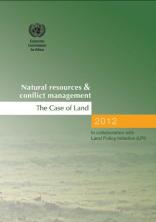Natural resources and conflict management: the case of land

Eastern Africa, like the rest of Africa, is the scene of many disputes related to land and natural resources. This partly emanates from the increasing demand on these resources because of population growth, but also as a result of the continued depletion of these resources in both quantity and quality due to degradation, overuse and over-harvesting, governance deficits, and external factors such as climate change and commercial pressure.
This paper, commissioned by ECA Sub-Regional Office for Eastern Africa (SRO-EA) and the AUC- ECA- AfDB Land Policy Initiative (LPI) was prepared to inform the Ad-Hoc Expert Group Meeting (AEGM) on “Natural resource management and conflict: the case of land”, held in the margins of the inter-governmental Committee of Experts (ICE) on 14-15 February 2012 in Dar es Salaam, Tanzania.
The main objective of the paper is to provide a presentation of the diversity of land related conflicts in Eastern Africa, an analysis of underlying causes of conflicts and experiences in conflict resolution and, lessons learnt and best practices from the policy and legal responses and links with enhancement of land governance in the region.
The Eastern African Region covered by SRO-EA is made up of 13 countries namely: Burundi, the Comoros, Democratic Republic of Congo (DRC), Djibouti, Eritrea, Ethiopia, Kenya, Madagascar, Rwanda, Seychelles, Somalia, Tanzania, and Uganda. It is a diverse region which includes island countries, large and small countries and countries with abundant natural resources as well as countries threatened by desertification. A good number of these countries are also suffering from current or recent political strife.
Land is not only a source for livelihoods in the region. It also carries spiritual values and is a valuable economic asset. Mismanagement of land resources is resulting in loss of economic potential, and is jeopardizing peace and security.
The countries in the region have varying ecological contexts ranging from “green” Madagascar and forested DRC where the terrain varies from tropical rainforests to mountainous terraces, plateaus, savannas, dense grasslands, and mountains, to “desert” Djibouti and Somalia. Even within the same country the geographical context can differ, as is the case in Kenya with a semi-arid north and a lush and green central belt.
With the exception of Burundi, Comoros, Rwanda and Uganda, the region has less than 30% of its land arable. In the case of Djibouti, arable land is virtually non-existent. There is limited use of irrigation and fertilizers, and land degradation, including loss of top soil and deforestation, is on the increase. With the ever increasing population and population densities, pressure on available arable land is immense leading to conflicts and to the encroachment onto other land uses/communities (eg. forests).